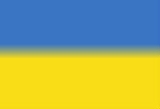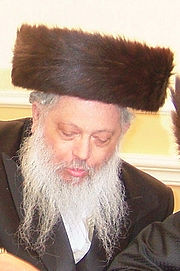
Khust
Encyclopedia
Khust is a culturally loaded term and has different meanings according to the context in which it is used. Initially, it was the ethnonym used for the East Slavic peoples who lived in Rus'. Later it was used predominantly for Ukrainians...
, 3,505 Hungarians and 1,535 Germans
Germans
The Germans are a Germanic ethnic group native to Central Europe. The English term Germans has referred to the German-speaking population of the Holy Roman Empire since the Late Middle Ages....
. Until the Treaty of Trianon
Treaty of Trianon
The Treaty of Trianon was the peace agreement signed in 1920, at the end of World War I, between the Allies of World War I and Hungary . The treaty greatly redefined and reduced Hungary's borders. From its borders before World War I, it lost 72% of its territory, which was reduced from to...
it belonged to Hungary
Hungary
Hungary , officially the Republic of Hungary , is a landlocked country in Central Europe. It is situated in the Carpathian Basin and is bordered by Slovakia to the north, Ukraine and Romania to the east, Serbia and Croatia to the south, Slovenia to the southwest and Austria to the west. The...
and was the seat of the Huszt district of Máramaros county. After World War I, in summer 1919 the Rumanian troops took over the territory. But according to the St.-Germain treaty Czechoslovakia received the city, as part of newly formed Podkarpatsko(Under the Carpathians) region. Czechoslovakia had to provide the region a wide autonomy, but it was realised only in 1938. In autumn 1938 an autonomous government was organised. On the other day after the collapse of Czechoslovakia on March 14, 1939, the government proclaimed an independence in Khust, that was not recognised by the leading states. One day later, on March 16, 1939 the Hungarian troops moved in. On October 24, 1944 the soviet troops occupied the city, and included it into the Soviet Union. The Soviet government exiled most of the city's German and Hungarian population. Since the collapse of USSR, Khust is part of Ukraine.
Demographics
In 2001 it had 31,900 inhabitants, including: http://www.ukrcensus.gov.ua/eng/results/general/nationality/Zakarpattia/- 28,500 (89.3%) UkrainiansUkrainiansUkrainians are an East Slavic ethnic group native to Ukraine, which is the sixth-largest nation in Europe. The Constitution of Ukraine applies the term 'Ukrainians' to all its citizens...
- 1,700 (5.4%) Hungarians
- 1,200 (3.7%) RussiansRussiansThe Russian people are an East Slavic ethnic group native to Russia, speaking the Russian language and primarily living in Russia and neighboring countries....
- 100 (0.4%) Roma (otherwise known as Gypsies)
Until the 19th century the city's population also included ethnic Romanians
Romanians
The Romanians are an ethnic group native to Romania, who speak Romanian; they are the majority inhabitants of Romania....
(800 Romanians according to the 1880 census).
Tourist sights
- Castle ruins
- Protestant fortress church 13th-14th century, Protestant since 1524, fortified in 1616, 1644, 1661 and 1670, restored in 1773 and 1888. Its belfry is from the 15th century, until 1861 it had four pinnacles.
- Roman Catholic church (BaroqueBaroqueThe Baroque is a period and the style that used exaggerated motion and clear, easily interpreted detail to produce drama, tension, exuberance, and grandeur in sculpture, painting, literature, dance, and music...
, 18th century) - Greek OrthodoxEastern Orthodox ChurchThe Orthodox Church, officially called the Orthodox Catholic Church and commonly referred to as the Eastern Orthodox Church, is the second largest Christian denomination in the world, with an estimated 300 million adherents mainly in the countries of Belarus, Bulgaria, Cyprus, Georgia, Greece,...
church (18th century)
Famous people
- Jenő Benda, writer, journalist was born here in 1882.
- Leslie BuckLeslie BuckLeslie Buck was an American business executive and Holocaust survivor who designed the Anthora coffee cup, which has become an iconic symbol of New York City since its introduction in the 1960s.-Early life:...
(born Laszlo Büch), American business executive and Holocaust survivor, designer of the AnthoraAnthoraThe Anthora is a paper coffee cup design that has become iconic of New York City daily life — its name is a play on the word amphora.The cup was originally designed by Leslie Buck of the Sherri Cup Co. in 1963, to appeal to Greek-owned coffee shops in New York City — and was later copied heavily by...
coffee cupCoffee cupA coffee cup may refer to a type of container from which coffee is consumed. Coffee cups are typically made of glazed ceramic, and have a single handle, allowing for portability while still hot...
, was born in Khust in 1922. - József Koller, historian of religion was born here in 1745.
- Ernő Szép writer was born here in 1894.
- Count József Teleki scientist was born here on December 21, 1738.
- Veronica Vovchuk (* 1990), Queen of the World, an international top model and actress with their own cosmetics line, "Queen Veronica"
Yeshiva
In 1861, Rabbi Moshe Moses Shick, known as the "Maharam ShikMaharam Shik
Rabbi Moshe Shik was a Rosh Yeshiva and Posek, and one of the leading Hungarian rabbis of his time ....
" established - what was at that time - the largest yeshiva
Yeshiva
Yeshiva is a Jewish educational institution that focuses on the study of traditional religious texts, primarily the Talmud and Torah study. Study is usually done through daily shiurim and in study pairs called chavrutas...
(Torah academy) in Eastern Europe, in Khust. This yeshiva had over 800 students.
Rabbis
- Grand Rabbi Dushinsky, (later the chief RabbiChief RabbiChief Rabbi is a title given in several countries to the recognized religious leader of that country's Jewish community, or to a rabbinic leader appointed by the local secular authorities...
of Jerusalem) was the Town Chief Rabbi, and was the Dean of one of the foremost Orthodox Jewish Seminaries, the Maharam Shiek Yeshiva. - Grand Rabbi Moshe GreenwaldMoshe GreenwaldMoshe Greenwald , also spelled Grunwald, was the Rav of Chust, Hungary and progenitor of the Puppa Hasidic dynasty through his five sons. He was also the author of Arugas Habosem, a book of responsa covering a wide breadth of halakhic issues.He was the eldest son of Rabbi Amram Greenwald , one of...
, author of Arugas Habosem, a book of responsa, was the Rav from 1887–1910; the Chust yeshiva experienced tremendous growth under his leadership.- Rabbi Yehoshua Greenwald, grandson of Rabbi Moshe GreenwaldMoshe GreenwaldMoshe Greenwald , also spelled Grunwald, was the Rav of Chust, Hungary and progenitor of the Puppa Hasidic dynasty through his five sons. He was also the author of Arugas Habosem, a book of responsa covering a wide breadth of halakhic issues.He was the eldest son of Rabbi Amram Greenwald , one of...
, served as Rav until the deportation of the community to AuschwitzAuschwitz concentration campConcentration camp Auschwitz was a network of Nazi concentration and extermination camps built and operated by the Third Reich in Polish areas annexed by Nazi Germany during World War II...
during World War II. After the war, he established a congregation for Chust HolocaustThe HolocaustThe Holocaust , also known as the Shoah , was the genocide of approximately six million European Jews and millions of others during World War II, a programme of systematic state-sponsored murder by Nazi...
survivors in the Borough Park section of BrooklynBrooklynBrooklyn is the most populous of New York City's five boroughs, with nearly 2.6 million residents, and the second-largest in area. Since 1896, Brooklyn has had the same boundaries as Kings County, which is now the most populous county in New York State and the second-most densely populated...
which his son-in-law Grand Rabbi Pinchos Dovid Horowitz, eldest son of Levi Yitzchak HorowitzLevi Yitzchak HorowitzLevi Yitzchak HeLevi Horowitz was a rabbi and the second Rebbe of the Boston Hasidic dynasty founded by his father, Rabbi Pinchas Horowitz...
the Bostoner Rebbe, now leads.
- Rabbi Yehoshua Greenwald, grandson of Rabbi Moshe Greenwald
- Grand Rabbi Yisroel Yaakov Leifer, youngest son and Successor by declaration of Rabbi Mordechai of NadvornaNadvorna (Hasidic dynasty)Nadvorna is a Hasidic rabbinical dynasty within Orthodox Judaism. The dynasty derives its name from the town of Nadvorna, known in Ukrainian as Nadvirna...
.- Grand Rabbi Shmuel Shmelke Leifer, son of Rebbe Yisroel Yaakov, author of the Beis Shmuel.
- Grand Rabbi Reuven Leifer of Viezer, son of Rebbe Yisroel Yaakov
- Grand Rabbi Dovid Leifer of Groirverdan, son of Rebbe Yisroel Yaakov
- Grand Rabbi Levi of Chust-Tosh
- Grand Rabbi Aharon Moishe Leifer, son of Rabbi Shmuel Shmelke.
- Grand Rabbi Shmuel Shmelka Leifer II of Chust
- Grand Rabbi Baruch Pinchos Leifer of Chust-Israel
- Grand Rabbi Turnauer of Chust-Williamsburg
- Grand Rabbi Meshullam Ginsberg of Chust, grandson and successor of Grand Rabbi Levi of Chust-Tosh
External links
- Khust in the Encyclopedia of Ukraine
- All about Khust City Includes a large image of the city and castle.
- Khust City elections in 2003
- Place names of Maramaros County

